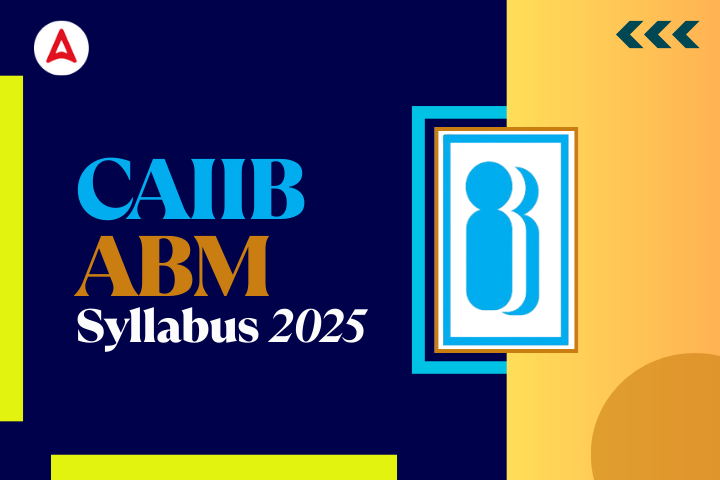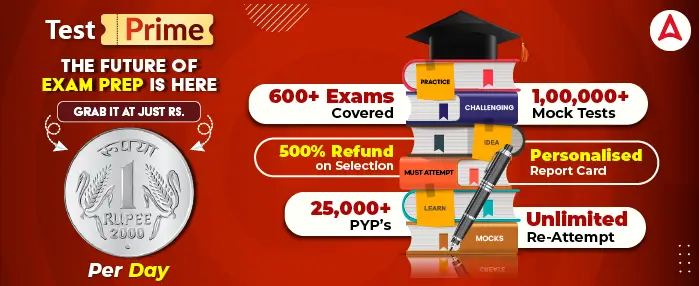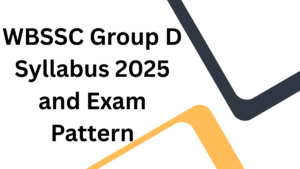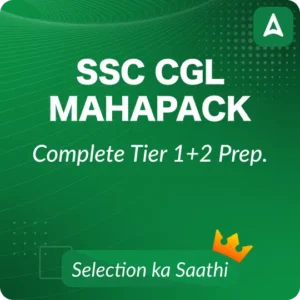The Indian Institute of Banking and Finance conducts the CAIIB Exam, aimed at enhancing the professional competence of banking professionals. The exam comprises four compulsory papers and one elective paper. The compulsory subjects include: Advanced Bank Management (ABM), Bank Financial Management (BFM), Advanced Business and Financial Management (ABFM), and Banking Regulations and Business Laws (BRBL). For the elective paper, candidates can choose one from the following options: Rural Banking, International Banking, Information Technology, Risk Management, or Central Banking.
CAIIB ABM Syllabus 2025, Exam Pattern & Topics to Prepare
The CAIIB ABM Syllabus 2025 consists of topics from 4 different modules, including Module A – Statistics, Module B – Human Resource Management, Module C – Credit Management and Module D – Compliance in Banks & Corporate Governance. This article provides an overview of the CAIIB ABM Syllabus 2025, Exam Pattern, and topics for effective preparation.
CAIIB Advanced Bank Management Syllabus 2025
The CAIIB Advanced Bank Management (ABM) Paper consists of 100 questions from 4 modules. The module-wise CAIIB ABM Syllabus has been provided here:
CAIIB Advanced Bank Management Syllabus Module A: Statistics
- Definition of Statistics, Importance & Limitations & Data Collection, Classification & Tabulation: Importance of Statistics; Functions of Statistics; Limitations or Demerits of Statistics; Definitions; Collection of Data; Classification and Tabulation; Frequency Distribution
- Sampling Techniques: Random Sampling; Sampling Distributions; Sampling from Normal Populations; Sampling from Non-Normal Populations; Central Limit Theorem; Finite Population Multiplier
- Measures of Central Tendency & Dispersion, Skewness, Kurtosis: Arithmetic Mean; Combined Arithmetic Mean; Geometric Mean; Harmonic Mean; Median and Quartiles; Mode; Introduction to Measures of Dispersion; Range and Coefficient of Range; Quartile Deviation and Coefficient of Quartile Deviation; Standard Deviation and Coefficient of Variation; Skewness and Kurtosis
- Correlation and Regression: Scatter Diagrams; Correlation; Regression; Standard Error of Estimate
- Time Series: Variations in Time Series; Trend Analysis; Cyclical Variation; Seasonal Variation; Irregular Variation; Forecasting Techniques
- Theory of Probability: Mathematical Definition of Probability; Conditional Probability; Random Variable; Probability Distribution of Random Variable; Expectation and Standard Deviation; Binomial Distribution; Poisson Distribution; Normal Distribution; Credit Risk; Value at Risk; Option Valuation
- Estimation: Estimates; Estimator and Estimates; Point Estimates; Interval Estimates; Interval Estimates and Confidence Intervals; Interval Estimates of the Mean from Large Samples; Interval Estimates of the Proportion from Large Samples
- Linear Programming: Graphic Approach; Simplex Method
- Simulation: Simulation Exercise; Simulation Methodology
CAIIB Admit Card 2025 Out- Click to Check
CAIIB ABM Syllabus Module B: Human Resource Management
- Fundamentals of Human Resource Management: The Perspective; Relationship between HRM & HRD and their Structure and Functions; Role of HR Professionals; Strategic HRM; Development of HR Functions in India
- Development of Human Resources: HRD and its Subsystems; Learning and Development – Role and Impact of Learning; Attitude Development; Career Path Planning; Self-Development; Talent Management; Succession Planning
- Human Implications of Organisations: Human Behaviour and Individual Differences; Employees’ Behaviour at Work; Diversity at Workplace and Gender Issues; Theories of Motivation and their Practical Implications; ‘Role’: Its Concept & Analysis; Employees’ Feedback and Reward System; Employees’ Feedback; Reward and Compensation System
- Performance Management: Appraisal Systems; Performance Review and Feedback; Counselling; Competency Mapping and Assessment of Competencies; Assessment Centres; Behavioural Event Interview (BEI) Conflict Management and Negotiation Conflict: Concept & Definition; Characteristics of Conflict; Types of Conflicts; Reasons for Conflict; Different Phases of Conflict; Conflict Resolution; Conflict Management; Negotiation Skills for Resolution of Conflicts
- HRM and Information Technology: Role of Information Technology in HRM; HR Information and Database Management; Human Resource Information System (HRIS); Human Resource Management System (HRMS); e–HRM; HR Research; Knowledge Management; Technology in Training; HR Analytics
CAIIB ABM Syllabus Module C: Credit Management
- Overview of Credit Management: Importance of Credit; Historical Background of Credit in India; Principles of Credit; Types of Borrowers; Types of Credit; Components of Credit Management; Role of RBI Guidelines in Bank’s Credit Management
- Analysis of Financial Statements: Which are the Financial Statements; Users of Financial Statements; Basic Concepts Used in Preparation of Financial Statements; Accounting Standards (AS); Legal Position Regarding Financial Statements; Balance Sheet; Profit and Loss Account; Cash Flow Statement; Funds Flow Statement; Projected Financial Statements; Purpose of Analysis of Financial Statements by Bankers; Rearranging the Financial Statements for Analysis; Techniques used in Analysis of Financial Statements; Creative Accounting; Related Party Transactions
- Working Capital Finance: Concept of Working Capital; Working Capital Cycle; Importance of Liquidity Ratios; Methods of Assessment of Bank Finance; Working Capital Finance to Information Technology and Software Industry; Bills/Receivables Finance by the Banks; Guidelines of RBI for Discounting/Rediscounting of Bills by Banks; Trade Receivables Discounting System (TReDS); Non-Fund Based Working Capital Limits; Other Issues Related to Working Capital Finance
- Term Loans: Important Points about Term Loans; Deferred Payment Guarantees (DPGs); Difference between Term Loan Appraisal and Project Appraisal; Project Appraisal; Appraisal and Financing of Infrastructure Projects
- Credit Delivery and Straight Through Processing: Documentation; Third-Party Guarantees; Charge over Securities; Possession of Security; Disbursal of Loans; Lending under Consortium/Multiple Banking Arrangements; Syndication of Loans; StraightThrough Loan Processing or Credit Underwriting Engines
- Credit Control and Monitoring: Importance and Purpose; Available Tools for Credit Monitoring/Loan Review Mechanism (LRM)
- Risk Management and Credit Rating: Meaning of Credit Risk; Factors Affecting Credit Risk; Steps taken to Mitigate Credit Risks; Credit Ratings; Internal and External Ratings; Methodology of Credit Rating; Use of Credit Derivatives for Risk Management; RBI guidelines on Credit Risk Management; Credit Information System
- Restructuring/Rehabilitation and Recovery: Credit Default/Stressed Assets/NPAs; Wilful Defaulters; Non-cooperative borrowers; Options Available to Banks for Stressed Assets; RBI Guidelines on Restructuring of Advances by Banks; Available Frameworks for Restructuring of Assets; Sale of Financial Assets
- Resolution of Stressed Assets under Insolvency and Bankruptcy Code 2016: Definition of Insolvency and Bankruptcy; To Whom the Code is Applicable; Legal Elements of the Code; Paradigm Shift; Corporate Insolvency Resolution Process; Liquidation Process; Pre-packed Insolvency Resolution Process for stressed MSMEs
CAIIB ABM Syllabus Module D: Compliance in Banks & Corporate Governance
- Compliance Function in Banks: Compliance Policy; Compliance Principles, Process and Procedures; Compliance Programme; Scope of Compliance Function; Role & Responsibilities of Chief Compliance Officer (CCO)
- Compliance Audit: Role of Risk-Based Internal Audit and Inspection; Reporting Framework and Monitoring Compliance; Disclosure Requirements; Accounting Standards; Disclosures under Listing Regulations of SEBI
- Compliance Governance Structure: Organisational Structure; Responsibility of the Board and Senior Management; Compliance Structure at the Corporate Office; Functional Departments; Compliance Structure at Field Levels; Internal Controls and its Importance
- Framework for Identification of Compliance Issues and Compliance Risks: Compliance Issues; Compliance Risk; Inherent Risk and Control Risk; Independent Testing and Effective Audit Programme; Reporting Framework and Monitoring Compliance; Role of Inspection and Audit; Loan Review Mechanism/Credit Audit; What is Good Compliance
- Compliance Culture and GRC Framework: How to Create Compliance Culture Across the Organisation; Governance, Risk and Compliance – GRC Framework; Benefits of an Integrated GRC Approach; Whistle-blower Policy; The Components of a Whistle-blower Policy; Reasons for Compliance Failures
- Compliance Function and Role of Chief Compliance Officer in NBFCs: Framework for Scale-Based Regulation for Non-Banking Financial Companies; Transition Path; Framework for Compliance Function and Role of Chief Compliance Officer in Non-Banking Financial Companies in Upper Layer and Middle Layer (NBFC-UL & NBFC-ML)
- Fraud and Vigilance in Banks: Definition of Fraud; Definition of Forgery; Areas in which Frauds are committed in Banks; Banking and Cyber Frauds; Fraud Reporting and Monitoring System; Vigilance Function in Banks; RBI Guidelines for Private Sector and Foreign
CAIIB Advanced Bank Management Exam Pattern 2025
The Advanced Bank Management (ABM) paper is one of the four compulsory subjects in the CAIIB 2025 Exam. Understanding the exam pattern is essential for effective preparation. Here are the important details of the CAIIB ABM Exam Pattern 2025.
- The ABM paper will consist of 100 multiple-choice questions (MCQs).
- The total duration to complete the paper is 2 Hours.
- There will be no negative marking in the paper.
- The paper will be bilingual, i.e. in both English and Hindi.
| Related Posts | |
| CAIIB Previous Year Question Papers | CAIIB Exam Pattern |
| CAIIB Study Material |
|




 WBSSC Group D Syllabus 2025 and Exam Pat...
WBSSC Group D Syllabus 2025 and Exam Pat...
 WBSSC Group C Syllabus and Exam Pattern ...
WBSSC Group C Syllabus and Exam Pattern ...
 GSSSB Fireman Driver Syllabus 2026, Chec...
GSSSB Fireman Driver Syllabus 2026, Chec...




 Adda247 Job portal has complete information about all Sarkari Jobs and Naukri Alerts, its latest recruitment notifications, from all state and national level jobs and their updates.
Adda247 Job portal has complete information about all Sarkari Jobs and Naukri Alerts, its latest recruitment notifications, from all state and national level jobs and their updates.



